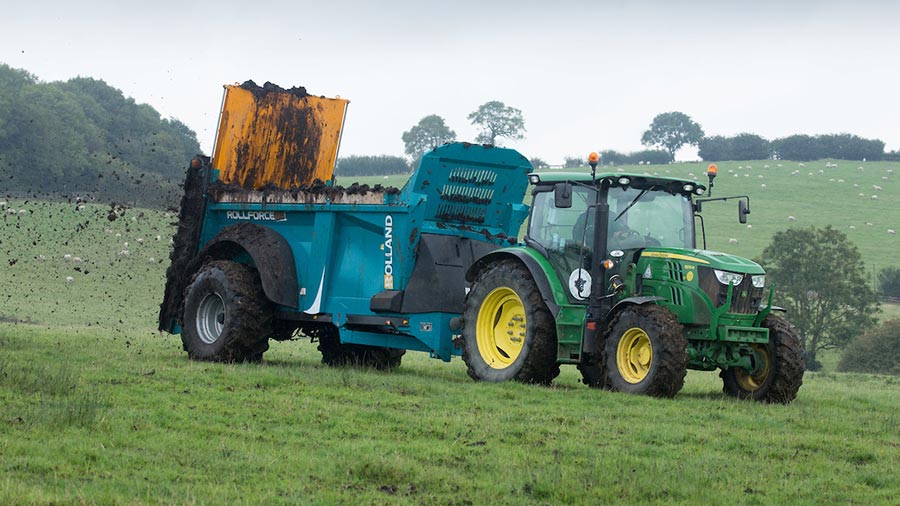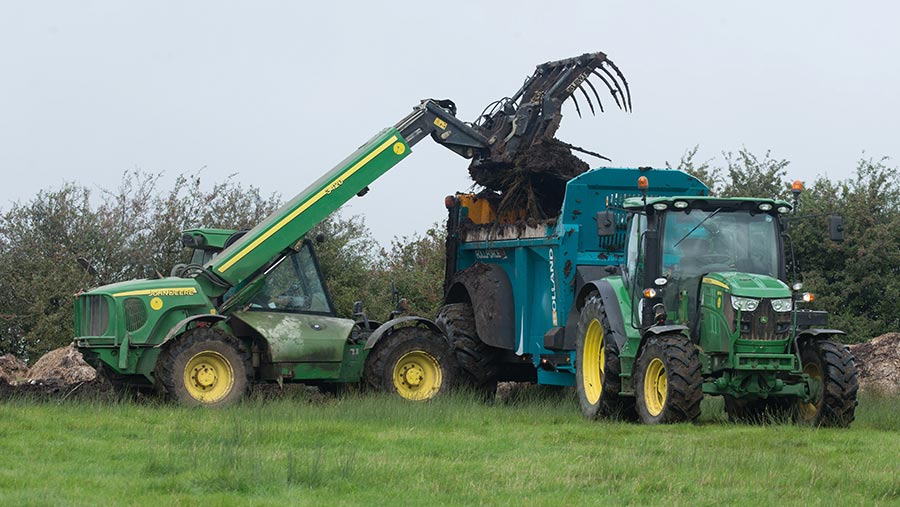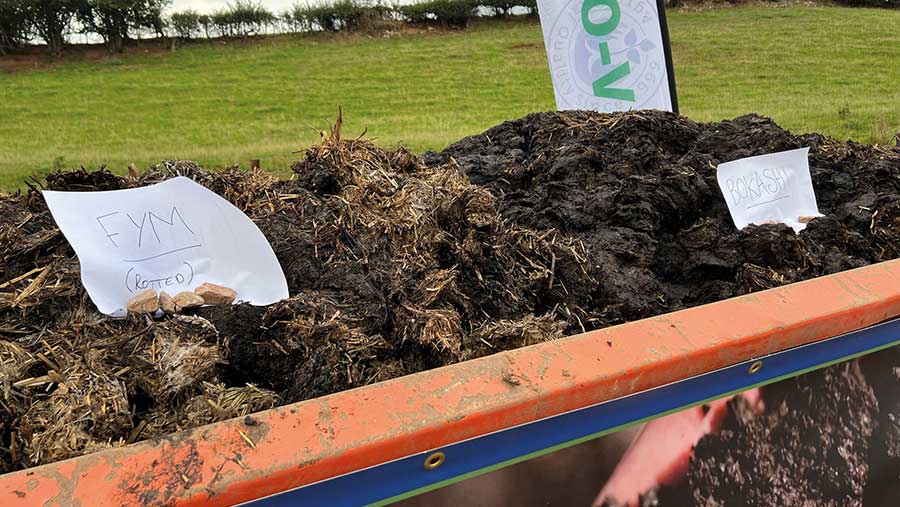How to store, analyse and spread organic manure for best value
 © Tim Scrivener
© Tim Scrivener Organic manures from livestock have always been a valuable source of fertiliser, but the high nitrogen prices of recent times have pushed this into sharper focus.
Just how valuable muck is depends on a number of factors, including how it is stored, whether it is analysed, and how and when it is applied to fields, says Lizzie Sagoo, soil scientist at Adas.
See also: How legumes, muck and slurry can help cut fertiliser bill
“Livestock manures contain plant nutrients and organic matter, so it’s possible to put a financial value on the material to reflect its nutrient value [and calculate] the saving you would make from using the manure to supply those nutrients, as opposed to buying them in,” she says.
Although quantifying the value of the organic matter is more challenging, Dr Sagoo says the growing awareness of the importance of organic matter in building soil health – and the subsequent benefit this has on crop and grassland growth – is helping to demonstrate what a valuable resource muck can be.
Here, Dr Sagoo shares some top tips to help growers get more bang for their buck when it comes to muck.
Storage
While storage methods for liquid and solids differ, the ability to store – rather than use immediately – enables farmers to spread at the optimum time, within legal restrictions, explains Dr Sagoo.
Field heaps are the most common method of storage for solids, but this can lead to loss of nutrients. The main concern is loss of nitrogen, which occurs as a result of ammonia volatilisation – the main pathway – and nitrate leaching.
Ammonia volatilisation can be minimised by covering heaps with a waterproof sheet. For poultry manures without bedding or litter, it is a legal requirement to cover heaps.
The location of heaps within fields is important, and AHDB’s Nutrient Management Guide (RB209) sets out the advice and regulations on this. For farms in a nitrate vulnerable zone (NVZ), the key storage principles to remember are that muck should not be stored:
- On any land that is likely to flood or become waterlogged
- Within 10m of surface water, including ditches, rivers and ponds, or land drains, or within 30m if the land slopes at 30deg or more
- Within 50m of a spring well or borehole.
Heaps should be moved every 12 months and a two-year gap should be left before returning to a site.
New methods of storage, such as fermenting and composting, are becoming more popular as a means to improve muck quality (see “Bokashi benefits”).
However, Dr Sagoo warns that these practices come at an additional cost, so it is important to ensure there is evidence to show they will bring an additional benefit.
Nutrient analysis
More farmers are now getting their manure analysed, says Dr Sagoo, who adds that this is worthwhile as there is often significant variability in the nutrient quality of manures.
These differences can be down to factors such as different livestock diets. For solid muck, quality is also affected by bedding materials and storage.
The risk with not analysing muck is that farms could be over- or under-dosing other nutrients, which will in turn affect the performance of the grassland or crops it is applied to.
At a basic level, the RB209 guide provides averages for the nutrient content of muck and slurry. But for a more advanced analysis, samples can be sent to a laboratory.

Solid muck can be harder to measure and quantify than liquids © Tim Scrivener
To get a reliable analysis, the sample needs to be representative of the material that is actually being spread.
One option is to sample while spreading, either out of the hose when applying liquid, or collecting small samples of the solid.
Another method is to sample from the heap.
When doing this, farmers should dig down into the heap, taking multiple samples from different parts of the store and mixing them together to get a more representative result, says Dr Sagoo.
Adas research has also shown positive results from nutrient analysis of slurry using near-infrared (NIR) spectroscopy.
This can be seen in John Deere’s HarvestLab tool, which enables the slurry to be analysed using a single internal sensor.
This real-time analysis means application rates can be adapted on the go, offering farmers a potential step-up in terms of manure management in the future, says Dr Sagoo.
Spreading
The method used for spreading will depend on whether the manure is solid or liquid.
But either way, it is vital that farmers take the same amount of care when applying organic manures as they do with bagged inputs, says Dr Sagoo.
This includes regular maintenance and calibration of machinery prior to spreading, to ensure even and accurate application.
Understanding application rates of organic materials is also important.
How much is being applied is relatively easy to monitor when spreading liquid via a pump with a known output rate, or a tanker with a known volume, but can be more challenging with solid muck.
She advises weighing a trailer when full and empty.
If this is not possible, growers should use trailer dimensions to work out the capacity and then consider the bulk density of the material to calculate what is being applied.
Generally, the bulk density of muck is about 0.7t/cu m.
“Organic manure is incredibly valuable, but it doesn’t come with 20-10-10 on the bag,” she says.
“You have to take a bit of extra time to work out what’s in it and what’s spread, to properly integrate it into your nutrient management plan.
“If you don’t, there is a risk that you’ll over- or under-apply and each of those scenarios has financial and environmental consequences.”
Bokashi benefits

A side-by-side comparison of rotted farmyard manure and fermented bokashi © Charlotte Cunningham
Fermenting muck – via a process called “bokashi” – is an alternative option to traditional field heap storage.
Bokashi is a Japanese term for fermented organic matter, and the process involves adding a starter culture of bacteria to the muck and ensiling it in a way similar to silage.
This creates anaerobic conditions which cause the muck to ferment, explains Andrew Sincock, commercial director at Agriton, which supplies bacteria products.
The benefits of this are that muck stays cooler, retains more nutrients and leads to less carbon loss, compared with the aerobic processes that stored muck traditionally goes through.
“It’s really easy – most farmers are already making silage, so they’re aware of the principles,” explains Mr Sincock.
“It [involves] a weekly application of micro-organisms onto the bedding during the housed period.
“When they [farmers] come to muck the sheds out, they simply muck it out as they would normally, put it into a heap and cover it with a black plastic sheet.
“It’s not a huge job, it’s not massively labour intensive, but the benefits are certainly significant.”
